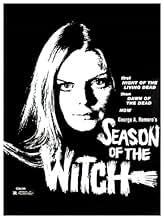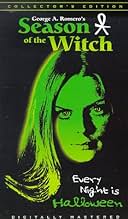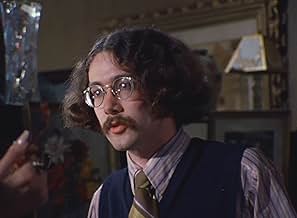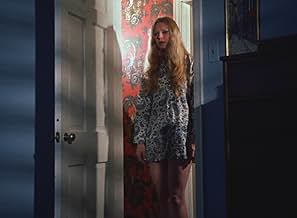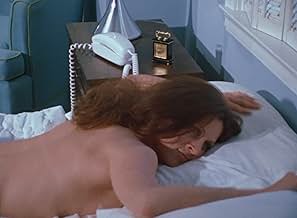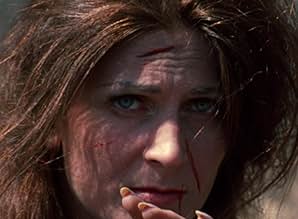NOTE IMDb
5,6/10
4,2 k
MA NOTE
Une femme au foyer de banlieue malheureuse qui s'ennuie se retrouve mêlée à la sorcellerie et au meurtre.Une femme au foyer de banlieue malheureuse qui s'ennuie se retrouve mêlée à la sorcellerie et au meurtre.Une femme au foyer de banlieue malheureuse qui s'ennuie se retrouve mêlée à la sorcellerie et au meurtre.
- Réalisation
- Scénario
- Casting principal
Raymond Laine
- Gregg
- (as Ray Laine)
Robert Trow
- Detective Mills
- (as Bob Trow)
Lynda Marnoni
- Patty
- (as Linda Creagan)
S. William Hinzman
- The Intruder
- (as Bill Hinzeman)
Avis à la une
Despite the fact that this film is by George Romero and it's sold as a horror film, _Season of the Witch_ (aka _Jack's Wife_ which is, in my opinion, the better title) isn't really a horror film.
Or, at the very least, it isn't a *straightforward* horror film and anyone going into this expecting Romero's typical gore and suspense will definitely be disappointed. The closest the film comes to typical horror are some wonderfully eerie sequences involving a man in a grotesque satanic-looking rubber mask (exploitatively depicted on some of the older videocassette sleeve covers for the film) trying to break into the main character's house.
What this film amounts to is the story of one woman who finds herself dissatisfied with the daily plod of her existence as a respectable wife in a respectable suburb. She feels herself aging. She's secretly bitter toward her husband and her friends. It's never really clear what she wants exactly because she doesn't seem to know herself, but she does become intrigued by a woman in the neighborhood who claims to a witch. She meets with this woman and, though she's afraid of black magic, she's inspired to explore it on her own. She goes out and buys a book on the subject and some witchcraft paraphernalia and then begins casting spells from her kitchen.
Despite the non-gory subject matter, there are some things in this film that bear the distinctive signature of Romero and his influences. There's a keen visual wit on display, particularly in some scenes involving mirrors. There are some odd hallucinatory dream sequences here that come straight from the more supernatural side of Italian horror (particularly the opening scene). Many of the scenes are ramshackle and crudely staged, but not in an altogether bad way. Rather, they almost recall a documentary. There's genuine tension (but not "horror film" tension). You don't know where scenes are going to go or what the characters are going to do or say next. You never really get inside many of the characters, but they're offbeat and watchable (particularly the young student-teacher, who's into drugs, casual sex, and some pretentious post-late 60's philosophy).
Not everything in this film works. It's badly edited. Much of the acting is weak. However, the film does have an intriguing, almost New Wave, experimental-like cadence. It's rough and full of jagged edges, but, in that respect, it's really no worse than Jean Luc-Godard at his most indulgent. Even more so than _Martin_, this is Romero's "art film". If it were a piece of music instead of a movie it would be slow, discordant and lo-fi.
This is recommended for all Romero admirers to see at least once.
Or, at the very least, it isn't a *straightforward* horror film and anyone going into this expecting Romero's typical gore and suspense will definitely be disappointed. The closest the film comes to typical horror are some wonderfully eerie sequences involving a man in a grotesque satanic-looking rubber mask (exploitatively depicted on some of the older videocassette sleeve covers for the film) trying to break into the main character's house.
What this film amounts to is the story of one woman who finds herself dissatisfied with the daily plod of her existence as a respectable wife in a respectable suburb. She feels herself aging. She's secretly bitter toward her husband and her friends. It's never really clear what she wants exactly because she doesn't seem to know herself, but she does become intrigued by a woman in the neighborhood who claims to a witch. She meets with this woman and, though she's afraid of black magic, she's inspired to explore it on her own. She goes out and buys a book on the subject and some witchcraft paraphernalia and then begins casting spells from her kitchen.
Despite the non-gory subject matter, there are some things in this film that bear the distinctive signature of Romero and his influences. There's a keen visual wit on display, particularly in some scenes involving mirrors. There are some odd hallucinatory dream sequences here that come straight from the more supernatural side of Italian horror (particularly the opening scene). Many of the scenes are ramshackle and crudely staged, but not in an altogether bad way. Rather, they almost recall a documentary. There's genuine tension (but not "horror film" tension). You don't know where scenes are going to go or what the characters are going to do or say next. You never really get inside many of the characters, but they're offbeat and watchable (particularly the young student-teacher, who's into drugs, casual sex, and some pretentious post-late 60's philosophy).
Not everything in this film works. It's badly edited. Much of the acting is weak. However, the film does have an intriguing, almost New Wave, experimental-like cadence. It's rough and full of jagged edges, but, in that respect, it's really no worse than Jean Luc-Godard at his most indulgent. Even more so than _Martin_, this is Romero's "art film". If it were a piece of music instead of a movie it would be slow, discordant and lo-fi.
This is recommended for all Romero admirers to see at least once.
Ranks right up there with "The Witch Who Came From the Sea" and "The Stepford Wives" in the obsolete sub-genre of 70's women's lib horror. Arguably George Romero's most unusual and underrated film, this is less a horror film than a sociopolitical bitchslapping of the male-dominated American dream. Although witchcraft does play a part in this, the focus is largely on our leading lady's middle-aged, menopausal anguish...a feeling of solitary confinement in a pseudo-sterile life with an abusive/absent husband, thankless daughter, and a circle of ingenuine, gossipy "friends".
This is a very well done low-budget film, and comes highly recommended...although rigid horror buffs may end up disappointed. 7/10
This is a very well done low-budget film, and comes highly recommended...although rigid horror buffs may end up disappointed. 7/10
_hungry wives_ is sorely underrated by all viewers, and commentators here. no, it doesn't come close to equaling the indelible onslaught that is _night of the living dead_ -- nothing else in romero's oeuvre does, after all, not even _dawn_ -- but as a document from its time, it's a strange balance between the films which precede it (this is not, despite what some here have suggested, romero's second film -- it's his fourth!), viz. _there's always vanilla_ and _the crazies_.
strangely calm, and maybe low-key to a fault, this examination of an alienated housewife's numbing existence and slow infatuation with witchcraft is very much a part of the "personal films" movement of its era, and suggesting a glancing similarity to cassavettes is not unfounded. the first-generation feminism is certainly heavy-handed at this point, but the careful eye for detail that distinguishes all of romero's work, his compassion for his protagonist's melancholy (call it western pennsylvania social realism) and the ambivalent tone, notably at the end (not the "surprise ending," but what follows it), give this film as uneasy balance between horror and domestic drama. definitely worth seeing, and with as few expectations as possible. 7/10
strangely calm, and maybe low-key to a fault, this examination of an alienated housewife's numbing existence and slow infatuation with witchcraft is very much a part of the "personal films" movement of its era, and suggesting a glancing similarity to cassavettes is not unfounded. the first-generation feminism is certainly heavy-handed at this point, but the careful eye for detail that distinguishes all of romero's work, his compassion for his protagonist's melancholy (call it western pennsylvania social realism) and the ambivalent tone, notably at the end (not the "surprise ending," but what follows it), give this film as uneasy balance between horror and domestic drama. definitely worth seeing, and with as few expectations as possible. 7/10
In the years between his legendary "Night of the Living Dead" and his outbreak thriller "The Crazies", filmmaker George A. Romero was actually trying NOT to get pigeonholed as a horror director. This is one of his efforts from that era. It's not for hardcore horror fans; other than a few nightmare sequences, it barely flirts with that genre. It's more of a sometimes arty, sometimes exploitative drama about a suburban housewife named Joan Mitchell (Jan White). Rather dissatisfied with her lot in life, she begins to think about things such as extramarital sex, and the idea of dabbling in the occult.
The performances are better than one might expect for such an independent, regional production. Romero uses his script as a set-up for exploring themes such as self esteem & self expression, female oppression, and the generation gap. For a while, it's likely to cause some audience members to be regularly checking their watches, as it rambles on at too deliberate a pace. It begins to maintain interest more consistently after the one hour mark. Regarding its artistic ambitions, Romero does seem to be enjoying himself coming up with those dream sequences. And in terms of exploitative elements, there is nudity both female and male, but never very much violence or gore.
"Hungry Wives" is fairly serious, but not totally without humor. Fans of the directors' output may want to see it for completions' sake, but it's not going to be for every taste.
Six out of 10.
The performances are better than one might expect for such an independent, regional production. Romero uses his script as a set-up for exploring themes such as self esteem & self expression, female oppression, and the generation gap. For a while, it's likely to cause some audience members to be regularly checking their watches, as it rambles on at too deliberate a pace. It begins to maintain interest more consistently after the one hour mark. Regarding its artistic ambitions, Romero does seem to be enjoying himself coming up with those dream sequences. And in terms of exploitative elements, there is nudity both female and male, but never very much violence or gore.
"Hungry Wives" is fairly serious, but not totally without humor. Fans of the directors' output may want to see it for completions' sake, but it's not going to be for every taste.
Six out of 10.
To get the most out of 'Season Of The Witch' ignore the horror tag and put Romero's zombie movies out of your mind. This is more of a character study cum social document of an early 70s bored housewife's attempt to find meaning in her life. Faced with dull bourgeois conformity on one side, and a counter-culture that offers no real answers on the other, she eventually finds her own direction. Low budget, variable performances and all, I still found this to be a much more complex and accomplished movie than Romero's most recent effort 'Bruiser'. While it doesn't impress as much as his overlooked vampire gem 'Martin' (which shares certain similarities in approach and theme), it's not to be dismissed. It may not be entirely successful, but I highly recommend it.
Le saviez-vous
- AnecdotesAccording to director George A. Romero, in the commentary track he did for The Crazies (1973) in 2002, this is the only one of his films he'd like to remake. He cited lack of money as a reason for unhappiness with this production as it turned out.
- GaffesThe name on the MasterCharge card Joan uses to buy her witchcraft supplies is "George A Romero".
- Citations
Shirley: [reading from the Witchcraft primer] 'The religion offers, further, a retreat for emotional women, repressed women, masculine women and those suffering from personal disappointment or nervous maladjustment.' Christ, what other kind of women are there? No wonder this stuff's getting so damn popular.
- Versions alternativesOriginally filmed and released in 1971 under the title "Hungry Wives" which ran at 130 minutes, the movie was re-edited for foreign distribution and re-released as "Jack's Wife" a year later, running at 104 minutes. In response to George A. Romero's successful release of "Creepshow" in 1982, "Jack's Wife" was released on home video as "Season of the Witch" with the running time trimmed further to 89 minutes. The current video version runs 104 minutes which is the original overseas version titled "Jack's Wife."
- ConnexionsFeatured in The Dead Will Walk (2004)
- Bandes originalesSeason of the Witch
Written and Performed by Donovan
Meilleurs choix
Connectez-vous pour évaluer et suivre la liste de favoris afin de recevoir des recommandations personnalisées
- How long is Season of the Witch?Alimenté par Alexa
Détails
Box-office
- Budget
- 90 000 $US (estimé)
Contribuer à cette page
Suggérer une modification ou ajouter du contenu manquant

Lacune principale
By what name was Season of the witch (1972) officially released in India in English?
Répondre

